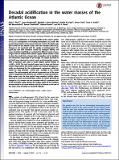Por favor, use este identificador para citar o enlazar a este item:
http://hdl.handle.net/10261/121612COMPARTIR / EXPORTAR:
 SHARE SHARE
 CORE
BASE CORE
BASE
|
|
| Visualizar otros formatos: MARC | Dublin Core | RDF | ORE | MODS | METS | DIDL | DATACITE | |

| Título: | Decadal acidification in the water masses of the Atlantic Ocean |
Autor: | Ríos, Aida F. CSIC; Resplandy, Laure; García-Ibáñez, Maribel I. CSIC ORCID ; Fajar, Noelia CSIC ORCID CVN; Velo, A. CSIC ORCID ; Padín, X. A. CSIC ORCID; Wanninkhof, Rik; Steinfeldt, Reiner; Rosón, Gabriel CSIC ORCID; Pérez, Fiz F. CSIC ORCID | Palabras clave: | Ocean acidification pH Anthropogenic carbon Water masses Climate models |
Fecha de publicación: | 2015 | Editor: | National Academy of Sciences (U.S.) | Citación: | Proceedings of the National Academy of Sciences of the USA 112(32): 9950-9955 (2015) | Resumen: | Global ocean acidification is caused primarily by the ocean’s uptake of CO2 as a consequence of increasing atmospheric CO2 levels. We present observations of the oceanic decrease in pH at the basin scale (50°S–36°N) for the Atlantic Ocean over two decades (1993–2013). Changes in pH associated with the uptake of anthropogenic CO2 (ΔpHCant) and with variations caused by biological activity and ocean circulation (ΔpHNat) are evaluated for different water masses. Output from an Institut Pierre Simon Laplace climate model is used to place the results into a longer-term perspective and to elucidate the mechanisms responsible for pH change. The largest decreases in pH (∆pH) were observed in central, mode, and intermediate waters, with a maximum ΔpH value in South Atlantic Central Waters of −0.042 ± 0.003. The ΔpH trended toward zero in deep and bottom waters. Observations and model results show that pH changes generally are dominated by the anthropogenic component, which accounts for rates between −0.0015 and −0.0020/y in the central waters. The anthropogenic and natural components are of the same order of magnitude and reinforce one another in mode and intermediate waters over the time period. Large negative ΔpHNat values observed in mode and intermediate waters are driven primarily by changes in CO2 content and are consistent with (i) a poleward shift of the formation region during the positive phase of the Southern Annular Mode in the South Atlantic and (ii) an increase in the rate of the water mass formation in the North Atlantic | Descripción: | 6 páginas, 5 figuras, 1 tabla.-- Proyecto Carbochange.-- Open access | Versión del editor: | http://dx.doi.org/10.1073/pnas.1504613112 | URI: | http://hdl.handle.net/10261/121612 | DOI: | 10.1073/pnas.1504613112 | E-ISSN: | 1091-6490 |
| Aparece en las colecciones: | (IIM) Artículos |
Ficheros en este ítem:
| Fichero | Descripción | Tamaño | Formato | |
|---|---|---|---|---|
| Decadal_acidification_PNAS_2015.pdf | 2,02 MB | Adobe PDF |  Visualizar/Abrir |
CORE Recommender
PubMed Central
Citations
4
checked on 14-abr-2024
SCOPUSTM
Citations
50
checked on 13-abr-2024
WEB OF SCIENCETM
Citations
38
checked on 29-feb-2024
Page view(s)
312
checked on 19-abr-2024
Download(s)
252
checked on 19-abr-2024
Google ScholarTM
Check
Altmetric
Altmetric
Artículos relacionados:
NOTA: Los ítems de Digital.CSIC están protegidos por copyright, con todos los derechos reservados, a menos que se indique lo contrario.
